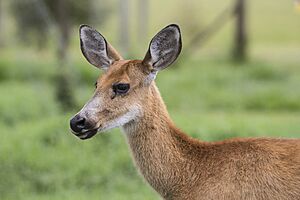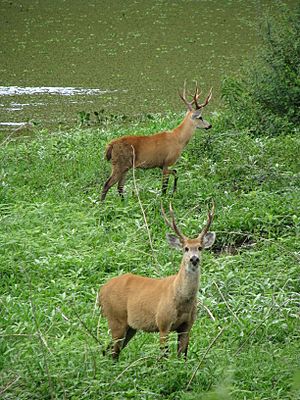Marsh deer facts for kids
Quick facts for kids Marsh deer |
|
|---|---|
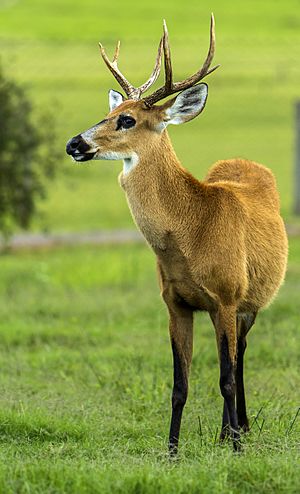 |
|
| Male marsh deer | |
| Conservation status | |
| Scientific classification | |
| Genus: |
Blastocerus
|
| Species: |
dichotomus
|
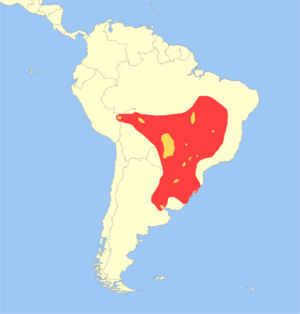 |
|
| Geographic range: Red=Former; Yellow=Present | |
The marsh deer (Blastocerus dichotomus) is the biggest deer in South America. It can grow up to 2 m (6.6 ft) long and stand 1.2 m (3.9 ft) tall at the shoulder.
You can find marsh deer in countries like Argentina, Bolivia, Peru, Brazil, Uruguay, and Paraguay. They used to live across many tropical and subtropical parts of South America. However, today they mostly live in small groups in marshy areas and lagoons. These areas are often near big rivers like the Paraná and Paraguay.
The marsh deer is considered a vulnerable species by the IUCN. This means it needs protection to survive. It is also protected under CITES Appendix I, which controls trade of endangered animals. The marsh deer is the only species in its group, called Blastocerus. Its scientific name, dichotomus, means "forked," which refers to its antlers.
Contents
What Does the Marsh Deer Look Like?
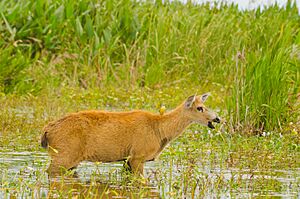
Marsh deer have very large ears with white fur inside. Their main fur color is a reddish-gold to tawny brown. Their eyes are dark, and their legs are long and dark. In winter, their fur gets even darker.
They also have white marks on their hips and around their eyes. Their lower legs and muzzle (nose area) are black. The tail is lighter red on top and black underneath. A marsh deer's body can be 153 to 200 cm (5.02 to 6.56 ft) long, with a tail adding another 12–16 cm (4.7–6.3 in). They stand about 100 to 127 cm (3.28 to 4.17 ft) tall at the shoulder.
Their hoofs are big and have stretchy skin between the toes. This helps them swim well and walk easily on soft, marshy ground. Only male marsh deer grow antlers. These antlers have branches and can reach up to 60 cm (23 inches) long. An adult marsh deer usually weighs 80 to 125 kg (176 to 276 lb). Some large males can even weigh up to 150 kg (330 lb).
Marsh Deer Life and Habits
Marsh deer usually live alone or in small groups of fewer than six deer. Often, these groups include only one adult male. Their main natural enemies are the jaguar and the puma.
Where Marsh Deer Live
Marsh deer only live in marshy areas, like the Pantanal and Chaco regions. The water in these areas is usually less than 70 cm (28 in) deep. They are very good swimmers.
The thick plants in the marshes help hide them from predators. These plants also provide them with food. Marsh deer sometimes move around, following the water levels between the dry season and the flood season. This helps them find new food sources that appear when the water goes down.
What Marsh Deer Eat
Since marsh deer live near water, they eat mostly aquatic plants. Scientists have found that they eat about 40 different kinds of plants. Their main foods include:
- Graminae (grasses) – about 22% of their diet
- Pontederiaceae (water hyacinths) – about 12%
- Leguminosae (legumes) – about 11%
They also eat other plants like water lilies, swamp shrubs, and plants that float on the water. They are known as "grazer-browsers" because they eat both grasses and leaves from plants. Their diet changes depending on whether it's the dry season or the flood season.
Marsh Deer Reproduction
The time when marsh deer mate, called the rutting season, often happens during the dry season. This might help them find partners more easily. During the dry season, more marsh deer gather in certain areas, making it simpler to find a mate.
A female marsh deer is pregnant for about 271 days. They usually give birth to one baby, but sometimes twins are born. Babies are born between October and November. Young marsh deer are whitish at birth. Their fur changes to look more like an adult's after about one year.
Protecting the Marsh Deer
The natural enemies of the marsh deer, like the jaguar and the puma, have mostly disappeared from where the deer live. In the past, hunting marsh deer for their antlers was a big problem. This is now more controlled.
Today, the biggest threat to marsh deer is the destruction of their habitat. For example, the Yacyretá Dam changed an area where many marsh deer lived. Also, people drain marshes to create farmland and raise cattle. This destroys hundreds of acres of marsh deer habitat every year in Argentina and Brazil.
Diseases from cattle can also be a problem for marsh deer. However, studies have shown that marsh deer are not affected by brucellosis, a common cattle disease. To help protect this species, Argentina created the Ciervo de los Pantanos National Park in October 2018.
See also
 In Spanish: Ciervo de los pantanos para niños
In Spanish: Ciervo de los pantanos para niños



